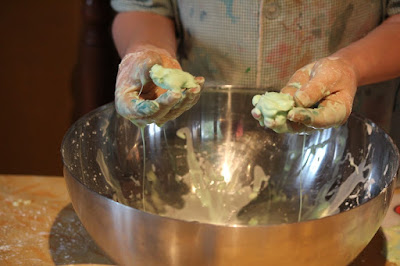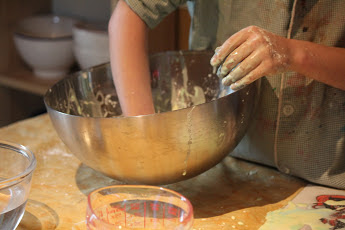Today I'm sharing with you three of the best experiments I've found to explore states of matter.
 |
| Maya and Noah in observation mode |
States of Matter Experiment 1 : Melting Chocolate
Melting chocolate is a really simple way for kids to talk about states of matter in particular solids and liquids. It's a concrete and practical exploration of what the properties of these two different states are. To make this more fun we combined this science experiment with a cookery experiment and tried our hand at making our own chocolate 'mendiants' - yum yum!
Materials
- Bars of chocolate (milk and dark)
- Mixed nuts and dried fruits cut into very small pieces (we used raisins, cranberries, candied ginger, hazlenuts, walnuts and cashews, dried apricots and figs).
- A bain-marie (we use a pyrex dish over a pan)
- Baking try lined with greaseproof paper
- spoons
- aprons
What we did
- First we looked at the bars of chocolate and discussed what state they were in and what were that state's characteristics (hard, brittle, holding its shape, etc).
- Next we broke the chocolate into small pieces and melted it in the bain-marie. We took it in turns to observe it and talked about the change that was taking place.
- Once it was fully liquid we talked about the properties of liquids (flow, take the shape of their container, etc).
- We discussed how we could transform the chocolate back into a solid. Heating it in the oven was suggested but we all agreed heating it was how it had melted so perhaps cooling it was best.
- We poured small spoonfuls of the liquid chocolate onto the lined baking tray and then sprinkled on different combinations of the dried fruit and nuts.
- We left the chocolats mendiants to set, checking on them regularly to see how they were doing.
Best for...
Kids who love chocolate, mums who love chocolate, Easter science activities, holiday season science experiments with gift-making. We really enjoyed this and the conversations we had were a great springboard for the rest of our work on states of matter.

Lotta ready to bake the scones!

States of Matter Experiment Two : Making Butter
It's an oldie but a goodie guaranteed to please everyone, young and old. This simple science experiment is not only fun to do but also provides a tasty treat at the end. You might want to make some delicious scones like we did to have something to spread your butter on.
Materials
- a clean jar
- a 240ml pot of double cream (a.k.a whipping cream)
What We Did
- First we poured the cream into the clean jar
- We discussed the 'state' of the cream (the kids successfully identified it as a liquid)
- We talked about how we could change it into a solid (heating it and cooling it were discussed). I explained to the children that we were going to try shaking it.
- We began shaking the jar, stopping regularly (5minute intervals) to observe what was happening. We recorded our observations. After about ten minutes we had yummy whipped cream (yes we tasted!). After about 20 to 25 minutes the butter was beginning to separate out.
- It took a bit longer, but we continued until we had a solid pat of butter, fully separated from the butter milk.
- We poured off the butter milk and stored it in another jar (we used it in pancakes later). We really enjoyed eating 'our' butter.
Best For ...
Younger kids. They really enjoy science that's also cooking but this doesn't have to mean excluding your older children. Mine were delighted to rediscover this experiment and extremely proud of the yummy butter they made. |
| Maya delights in the Oobleck |
States of Matter Experiment Three : Oobleck
Oobleck or Cornstarch goo is a lot of fun and a great way to explore states of matter. It's a non-newtonian liquid which means depending on how you handle it, it reacts either like a liquid or like a solid. Kids love it because it's messy and gooey. And mums or teachers if you're thinking that sounds horrible, don't worry it's suprisingly easy to clean up. It can't go down your drain but it can be fed to your plants and if you wait it eventually goes powdery again and easily brushes off things and into the bin.
Materials
- Corn Starch
- Water
- Food colouring
- Mixing Bowls
- Aprons
- Protective covering for your work surface
 |
| Flowing like a Liquid |
What we did
(for more detailed instructions check out sciencebob's tutorial which is the main one we used)
- First of all we poured about a cup of cornstarch into our bowls and played with it to get a feel for the texture.
- We poured half a cup of water into a measuring jug and added the food colouring of each child's choice to the water.
- We added enough water to the cornstarch mixing it in with our hands until it slowly flowed on its own. In our case this was pretty much all of it.
- We played with the cornstarch goo. And boy was it fun. I threw some ideas out at the kids in the form of what does it do if ... and they threw in some of their own. A happy hour or more was spend just testing out what this stuff can do.
- We cleaned up after a bit of googling to find out how best to do it. We then watched some very funny YouTube videos of people walking on, running across and playing around with Oobleck.
- We read up on the science of non-newtonian liquids.
 |
| Solid balls of Oobleck |
Best for ...
Everyone though particularly kids who love getting their hands dirty. When the kids had finished, I have to admit I had a go too. There's something magical about Cornstarch Goo, how it's at once a liquid and a solid. And it just feels so good! And we were all really impressed when Noah managed to hold his bowl in the air by holding on to the Oobleck inside, now if that's not magic... |
| Noah's bowl hovering over the table! |
All three of these experiments were fantastic, I really hope you'll try them with your kids. To support what we were learning through these hands on activities, we read up on the states of matter here and here. We also watched this great French kids documentary and this one in English. We then produced a visual schema showing what we'd learned about the three states and how matter changes from one state to another. After each experiment we do a little lab report which varies in style and detail according to the kids different ages and interest in written records. I'll share more about that soon and another fabulous states of matter experiment - the Lava Lamp!

No comments:
Post a Comment